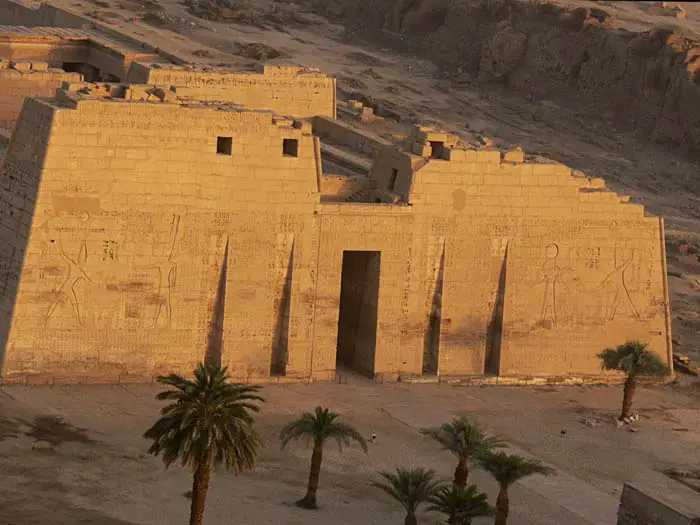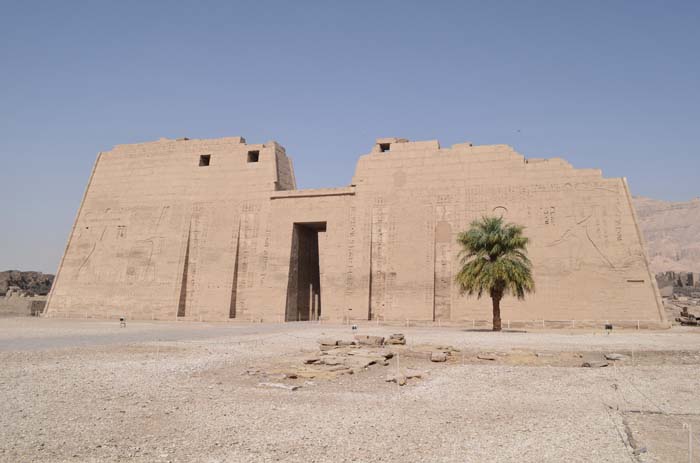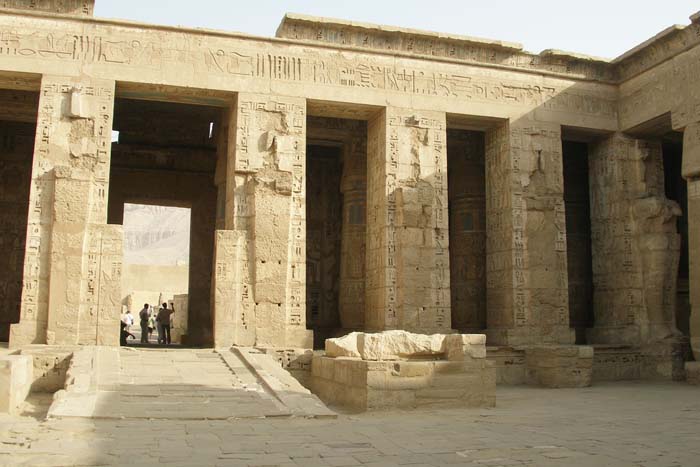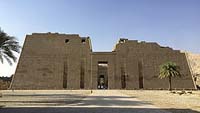Medinet Habu
Medinet Habu is the Arabic name for the mortuary temple of Ramses III. Located on the west bank of Luxor, this temple made of sandstone is the second largest complex in the area, the first being Karnak. It closely resembles the Ramesseum in structure and design.
The second pharaoh of the twentieth dynasty, Ramses III, is considered the last great pharaoh of Egypt and his mortuary temple is covered with reliefs of his conquests. His reign lasted from 1186 to 1155 BC. The memorial temple has 7,000 square meters of well-preserved decorated surfaces. Queen Hatshepsut and Thutmose III built the Medinet Habu temple; Ramses III later chose the site as his memorial temple, enclosing the original temple inside his complex.

© Walwyn - View of Medinet Habu
A Magical Site
Through the centuries, ancient Egyptians, as well as modern day local farmers considered the Medinet Habu temple to have magical powers. The temple protected the Theban people during the late 20th century dynasty during the Libyan invasions and was the site of many annual festivals in association with Amun, in his form as God of Fertility and Creator.
Syrian Influence
Ramses III modeled the entrance to his mortuary temple after the Syrian fortresses he had seen during his Syrian war campaigns. The Migdol Gate is based on the gatehouse of these Syrian citadels. This design gives the memorial temple a fortress look to it, especially since it was originally closed in by a 35’ thick, 60’ high mud brick wall. At the entrance also stand two statues of Sekhmet. Above the Migdol Gate is where Ramses III relaxed with his harem. The harem boasts reliefs of dancing girls.
Medinet Habu Design
A small temple stands to the right of the Migdol Gate that was originally built and decorated by Hatshepsut in 1490 BC. Across from this temple are the Chapels of Votaresses. These were added during the 25th Dynasty of Nubian Kings, dating back to the 700’s BC. Votaresses were the governors of Thebes and the high priestesses of Amun.
The main facade faces the southeast and is asymmetrical. A Ptolemaic Pylon juts out on the right side of the facade. The pylon, recently restored, is brightly decorated with a winged sun-disc.

© Daniel and Kate - Main facade of the Medinet Habu temple
In the southeast corner is the Sacred Lake, where women came to bathe and pray for fertility. A Nilometer is located here as well. Interestingly, a Nilometer measured both the Nile’s clarity and water level.
The first pylon shows various reliefs of war campaigns including some that are exaggerated for an impressive effect on the visitor. The first pylon’s inner wall shows scribes counting severed hands and genitals of enemies.

© Scott Sherrill-Mix - Reliefs on the First Pylon
Beyond the first pylon is a large first court. Surrounded by columns, the columns on the right depict Osiride statues of Ramses III being attended to by little queens. To the left of the first court is the royal Palace, and in the center of the adjoining wall is the Window of Appearances. The Window of Appearances is where the King rewarded devoted commanders with golden collars.

© Hannah Pethen - First court of the Medinet Habu temple
The second pylon is special because not only does it show reliefs of Ramses III leading prisoners of war to Amun and Mut, it also boasts inscriptions declaring his Asia Minor victories. Winged cobras and sun discs decorate the ceiling in the gateway.
The Hypostyle Hall past the second court now has no roof, but originally had a raised center aisle. Hieroglyph-covered bases of 24 pillars are all that remains. Five chapels dedicated to Ptah, Sokar, Osiris, Ramses II and Ramses III are to the right of the Hypostyle Hall, and chambers to the left are believed to have once held treasure.

© Elena Pleskevich - Pillar Bases in the Hypostyle Hall
To the left, the hall contains the funerary chamber of Ramesses III. Here, Thoth is inscribing the king’s name on the sacred tree of Heliopolis. Opposite this chamber is a roofless chamber that at one time contained an altar dedicated to Ra.
Statues of Ramses III accompanied by Thoth and Maat flank the second hall’s central aisle. This aisle leads back into sanctuaries dedicated to the Theban Triad. There is even a false door that was to be used for Ramses III’s soul.
Sea Peoples
During the king’s reign, many foreigners invaded ancient Egypt including the “Sea Peoples” and the Libyans. These “Sea Peoples,” based on evidence derived from the temple walls, were made up of the Peleset and Tjeker, also known as the Minoans of Crete. These inscriptions and reliefs were added to the mortuary temple walls eight years into the king’s reign.

© Vyacheslav Argenberg - Reliefs on the Walls of the Temple
Quick Medinet Habu Facts
- The northern outer walls contain the best, most well-preserved reliefs. Ramses III’s battle relief runs the whole length of this wall.
- Some of the reliefs found in the Medinet Habu Temple include a religious calendar, Ramses III expedition into Upper Egypt, Hunting the wild bull, Destruction of Hittite strongholds, Feast of Sokar, Ramses III making offerings to Amun, Naval battle against the Sea Peoples, and Equestrian scenes.
- Economic difficulties and internal strife caused the collapse of the 20th Dynasty. Considered the last great Pharaoh, Ramses III saw the decline of Egyptian power during his long reign.
- The excavation of Medinet Habu started in 1859 by the Egyptian Antiquities Service. Partially-intact enclosure walls surround the site, so a ride in a hot air balloon provides the best view of the complex.

